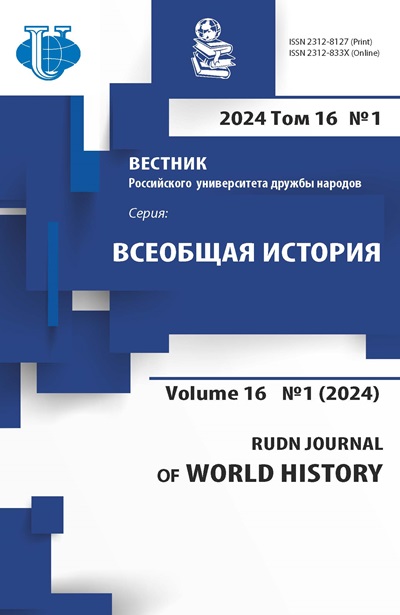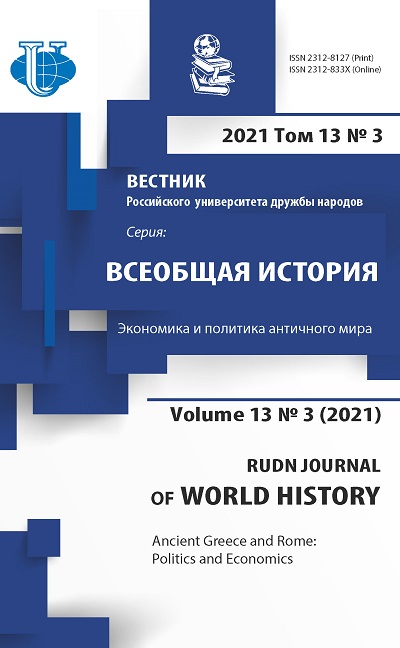Alkaios on the role of Mytilenian aristocracy in the economic life during stasis
- Authors: Solomatina Y.I.1
-
Affiliations:
- Institute of World History Russian Academy of Sciences
- Issue: Vol 13, No 3 (2021): Ancient Greece and Rome: Politics and Economics
- Pages: 269-276
- Section: ECONOMY AND POLITICS OF ANCIENT GREECE
- URL: https://journals.rudn.ru/world-history/article/view/27321
- DOI: https://doi.org/10.22363/2312-8127-2021-13-3-269-276
Cite item
Full Text
Abstract
The purpose of this paper is to analyze the evidence concerning different activities of aristocracy and if possible to define its role in the economic life during a very specific period in the history of archaic Mytilene, i.e. stasis. Alkaios’ poetry provides valuable information on the problem in question. Alkaios is one of the main witnesses and participants in the described events. Besides that, lyrics of Sappho, Alkaios’ contemporary, is used, her poems provide concrete examples which complete Alkaios’ evidence. The results of archaeological investigations corroborate the data of the written sources and shed light on those spheres of aristocracy activities that have not got evident representation in the authentic sources. We are talking about agriculture and the role of aristocracy in this economic sector and moreover about the land as a main source of material well-being of aristocracy. After all the land issue was always in the focus of poleis policy in time of peace as well as during turbulent political strife. Analyzed information from the set of available sources testifies to a very complicated role played by Mytilenian aristocracy in the economic life of Mytilene during stasis that is difficult to evaluate unambiguously. An important evaluation criterion of the role is possession of civil rights of which the losing party may be deprived during stasis while having to flee into exile. In the first case the role may be positive and in the second one negative.
Keywords
About the authors
Yelena Ivanovna Solomatina
Institute of World History Russian Academy of Sciences
Author for correspondence.
Email: Solomatina_elena@yahoo.com
Research Fellow Detachment for Comparative Studies of the Ancient Civilizations
32A, Leninsky pr-t, Moscow, Russian Federation, 119334References
- Osborne R. Greece in the Making, 1200–479 BC. London: Routledge, 1996.
- Forsdyke S. Exile, Ostracism, and Democracy. The Politics of Expulsion in Ancient Greece. Princeton & Oxford: Princeton University Press, 2005.
- Sappho et Alcaeus. Fragmenta. Ed. E.-M. Voigt. Amsterdam: Polak & van Gennep, 1971.
- Fantalkin A., Lytle E. Alcaeus and Antimenidas: Reassessing the Evidance for Greek Mercenaries in the Neo-Babylonian Army. Klio. 2016;98(1):90–117.
- Alcée. Fragments. Texte établi, traduit et annoté par G. Liberman. T. 1−2. Paris: Les Belles Lettres, 1999.
- Page DL. Sappho and Alcaeus. An Introduction to the Study of Ancient Lesbian Poetry. Oxford: Clarendon Press, 1955.
- Raaflaub KA. The Newest Sappho and Archaic Greek-Near Eastern Interactions. In: The Newest Sappho: P. Sapph. Obbink and P. GC inv. 105, frs. 1–4): Studies in Archaic and Classical Greek Song, vol. 2 (Mnemosyne Supplements 392). Ed. by A. Bierl, A. Lardinois. Leiden, Boston: Brill, 2016. P. 127–147.
- Diodorus of Sicily. The Library of History. With an English translation by C.H. Oldfather. In 12 volumes. Vol. IV: Books IX–XII (Loeb Classical Library). London: William Heinemann LTD, 1956 (reprint).
- Tandy D. Trade and Commerce in Archilochos, Sappho, and Alkaios. In: R. Rollinger and Ch. Ulf, eds., Commerce and Monetary Systems in the Ancient World: Means of Transmission and Cultural Interaction. Stuttgart: Fritz Steiner Verlag, 2004. P. 183–194.
- Rösler W. Dichter und Gruppe. Eine Untersuchung zu den Bedingungen und zur historischen Funktion früher griechischer Lyrik am Beispiel Alkaios. München: W. Fink, 1980.
- Obbink D. The Newest Sappho: Text, Apparatus Criticus, and Translation. In: The Newest Sappho: P. Sapph. Obbink and P. GC inv. 105, frs. 1–4): Studies in Archaic and Classical Greek Song, vol. 2 (Mnemosyne Supplements 392). Ed. by A. Bierl, A. Lardinois. Leiden, Boston: Brill, 2016. P. 13–33.
- Herodotus. The Persian Wars. Translated by A.D. Godley. In 4 volumes. Vol. I (Loeb Classical Library). Cambridge, MA: Harvard University Press, 1920.
- Strabo. Geography. With an English Translation by H.L. Jones. In 8 volumes. Vol. VIII (Loeb Classical Library). London: William Heinemann LTD, 1967.
- Suidae Lexicon. Ed. A. Adler. In 5 volumes. Leipzig: B.G. Teubner, 1967. Vol. IV: Π–Ψ. Leipzig: B.G. Teubner, 1971.
- Dupont P. Archaic East Greek Trade Amphoras. In: R.M. Cook and P. Dupont, eds., East Greek Pottery. London: Routledge, 1998. P. 142–191.
- Jeffery LH. The Local Scripts of Archaic Greece. A Study of the Origin of the Greek Alphabet and its Development from the Eighth to the Fifth Centuries B.C. Oxford: Oxford University Press, 1961.
- Spencer N. Exchange and Stasis in Archaic Mytilene. Alternatives to Athens: Varieties of Political Organization and Community in Ancient Greece. Ed. by R. Brock & S. Hodkinson. Oxford: Oxford University Press, 2000. P. 68−81.
- Myakin TG. Stanovlenie polisnogo stroja na Lesbose v VII–VI vv. do n.je. (jetnosocial’nyj aspekt) [The formation of the polis system in Lesbos in VII–VI cent. BC (ethno-social aspect)]. In: A.P. Derevyanko, ed., History and Sociology of the State. Novosibirsk: Novosibirsk State University Press, 2003. P. 5-12. (In Russ.).
- Surikov IE. Nekotorye problemy istorii drevnegrecheskih gorodov v regione chernomorskih prolivov [On Some Problems of History of Ancient Greek Cities in the Region of the Black Sea Straits]. Ancient World and Archaeology. Saratov: Saratov State University Press. 2013;(16):24-38.













